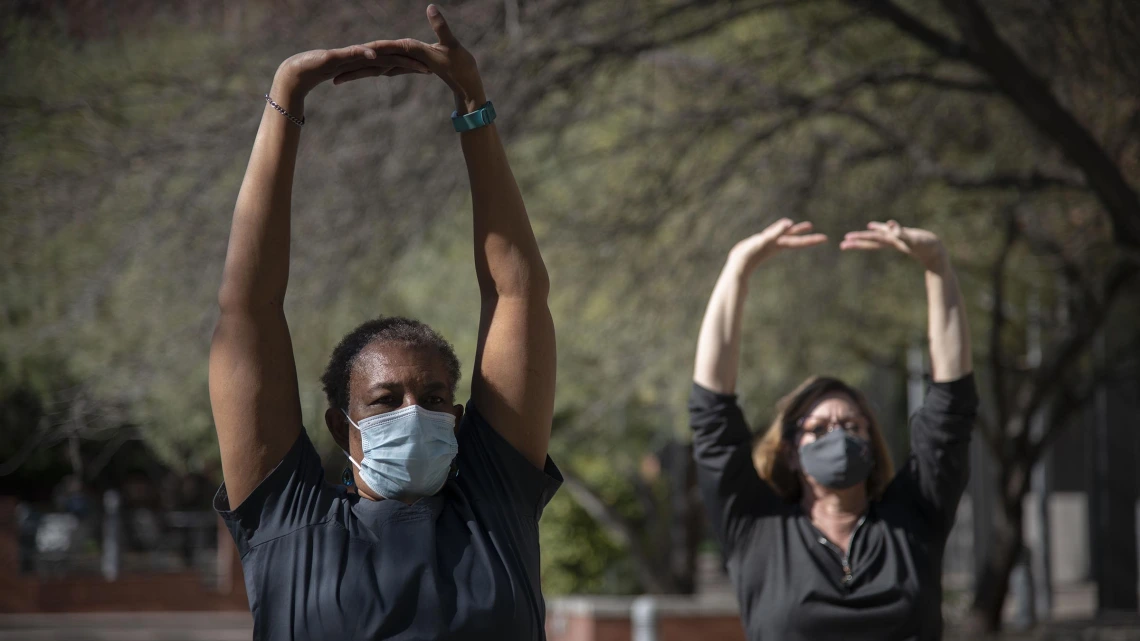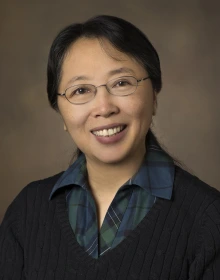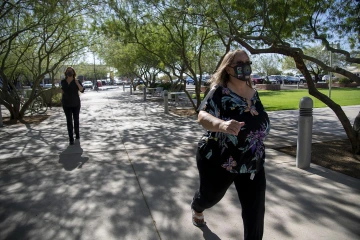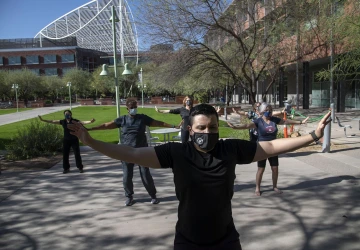Saguaro Study Supports Employees During Pandemic
An interprofessional team of researchers asked UArizona employees aged 50 and older what kind of support they need, then designed programs to provide it.

The Saguaro Study sought to find out what support employees need, and then provide it. Here, employees participate in an outdoor Tai Chi and Healthy Qigong session as part of the study.
Some University of Arizona faculty and staff who are at least 50 years old have concerns about keeping stress in check during the pandemic, while also maintaining physical activity and retaining social connections.

Zhao Chen, PhD, MPH
The Saguaro Study involves researchers from the Mel and Enid Zuckerman College of Public Health, the College of Nursing, the College of Medicine – Tucson and the Arizona Center on Aging. The team is led by principal investigator Zhao Chen, PhD, MPH, distinguished professor and chair of the Department Epidemiology and Biostatistics in the College of Public Health, and a member of the BIO5 Institute.
Dr. Chen is working with seven colleagues, including Amanda Sokan, PhD, MHA, LL. B, Nicole Yuan, PhD, MPH and Marc Verhougstraete, PhD, from College of Public Health; Kathleen Insel, PhD, RN, from the College of Nursing; and Mindy Fain, MD, Linda R. Phillips, RN, PhD, FAAN, FGSA and Lisa O’Neill, DBH, MPH, from College of Medicine – Tucson and Arizona Center on Aging.
Creating the team
Dr. Chen has been on the faculty at the university for more than 20 years and she directs the Healthy Aging Lab in College of Public Health. She said her deep knowledge of colleagues with varied research interests helped her identify a potential team of collaborators.

Many employees reported a reduction in physical activity during the pandemic, so campus walking routes were designed to help motivate movement.
“One of the things I love about your project is that you were getting not only information that most epidemiologists gather, in terms of discovery, but you also wanted to intervene,” Dr. Insel said to Dr. Chen during an interview. “The approach is: let’s get this information and then let’s do something with it.”
The approach is meant to have real impact on employee well-being, now and in the future, as the research continues to evaluate what the target group needs, Dr. Chen said.
Designing the project

Dagoberto Robles, a doctoral student in Epidemiology leads Tai Chi and Qigong sessions as part of the project.
More than 1,000 people answered questions about their stress level, their comfort interacting with others, whether they work remotely or on campus, and how their sleeping and eating patterns changed during the pandemic.
The main concerns were related to:
- lack of physical activity, due to reduced access to gyms or limited space at home;
- increased stress due to health concerns, or to balancing various responsibilities such as caring for children, grandchildren or parents;
- losing social connections or navigating intergenerational communication issues regarding the perceptions of COVID-19.
Implementing strategies
The second phase of the Saguaro Study involved developing interventions to help support employees with strategies to mitigate those concerns.
The interventions included virtual Tai Chi and Healthy Qigong courses, some of which Dr. Chen taught herself; walking routes on the UArizona campus developed to encourage safe movement while avoiding crowded areas; and mini meditation sessions to help people feel a sense of control in uncertain times. The team also plans to create guidance for navigating intergenerational communications after completing an ongoing study on ageism.
It was important to be aware of the myriad job duties and circumstances for university employees, said Dr. Insel, who was responsible for recruitment for the online survey part of the study.

Tai Chi and Qigong can be done outside with social distancing and masks as a way to engage in stress reduction and physical activity.
With that in mind, the team implemented the interventions in the fall of 2020, and plans a final survey, using quantitative and qualitative feedback, this spring.
Employees welcomed the intervention strategies. As the pandemic continued and UArizona officials approached the spring semester with a similar phased in-person approach, the team realized the project needed to continue.
“Spring semester is not going to be much different from the fall semester,” Dr. Chen said. “So, we still need to continually address people’s worries about weight gain, loss of quality sleep, not enough physical activity and sitting too long, as well as concerns about being around people and about getting sick themselves or their loved ones getting sick.”
The bright side
In the initial online survey, and in those conducted before and after interventions, the team gathered considerable data that could provide insights about the UArizona employees aged 50 and older.
“The good news is this population is resilient. So even while they may be facing fear, the answers really show it is not affecting their work. They’re still feeling things are under their control. They’re very competent to move forward. That’s the bright side,” Dr. Chen said.
The team saw some positive signals sprinkled throughout the surveys, as some people reported eating more fresh vegetables while working remotely.
Dr. Chen said it is clear that most people are eager to have extra support.
“Overwhelmingly, people want to have some intervention, they want have some social interactions and education, and ways to increase their interactions.”

